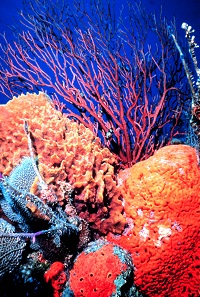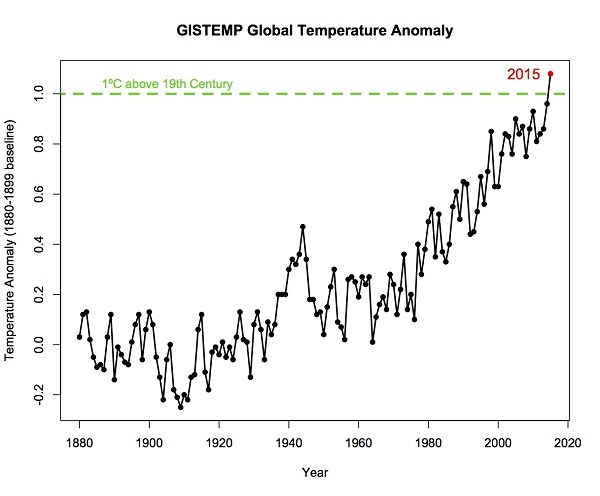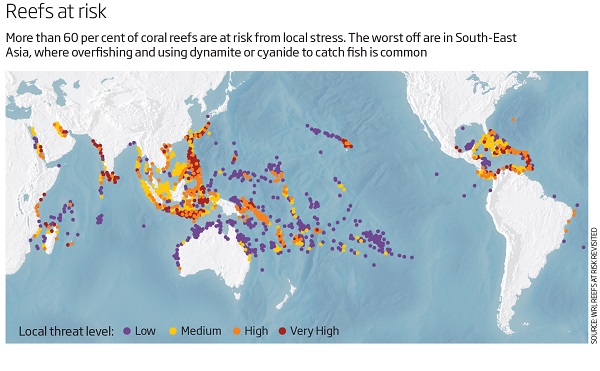 Recently we took a look at the most recent coral bleaching event in Great Barrier Reef will never be the same. John D subsequently sent me a link to an article Obituaries for coral reefs may be premature, study finds by John Pandolfi, Professor, School of Biological Sciences, at The University of Queensland.
Recently we took a look at the most recent coral bleaching event in Great Barrier Reef will never be the same. John D subsequently sent me a link to an article Obituaries for coral reefs may be premature, study finds by John Pandolfi, Professor, School of Biological Sciences, at The University of Queensland.
So I thought we should take a closer look.
Pandolfi’s bottom line is:
- While climate still remains a potentially deadly threat to much of the world’s coral reefs, combining this new study with these recent results means that predicting the global demise of reefs within the next couple of decades may be a bit premature. It’s more likely that, although reefs will be severely degraded, there will be large variability in their response to climate change.
Some corals will likely survive, providing the basis for recovery.
Pandolfi is definitely more optimistic than Professor Ove Hoegh-Guldberg, Director of the Global Change Institute and Professor of Marine Science at the University of Queensland, who told Emma Griffiths on local radio that under business as usual there would be no corals by about 2030 to 2040, just slime. Under a vigorous climate mitigation regime to limit warming to 2°C, some but not all would survive. Reefs would be severely degraded.
Pandolfi seems to be saying that under business as usual some reefs will survive.
Pandolfi was drawing on two pieces of research that I reported on in Climate clippings 145, Item 3, based on a New Scientist article (unfortunately paywalled).
The first was a study of 21 reefs in the Seychelles devastated to more than 90% in the coral bleaching event of 1998. Nine reefs underwent regime shifts to fleshy macroalgae but 12 substantially recovered. The authors found that more complex reefs in deeper water recovered.
The NS article makes clear, however, that recovery did not start to any observable degree until after 2006. The concern is that by 2030 we may have bleaching conditions every few years, or indeed every year. Given the trajectory of global surface temperatures since the 1970s you’d have to think that might be right:

The other research was by Malcolm McCulloch and associates of the University of Western Australia who
found that each of the individual polyps that make up corals isolates a drop of water inside its body, and de-acidifies it by removing hydrogen ions. This allows corals to build their reefs about 100 times faster than they could in ordinary seawater.
They found that some polyps had this ability, not all. He and his team concluded that “acidification had about half the impact on coral reef building than previously thought.”
McCulloch’s work was published in 2012, Pandolfi’s was in January 2015, the New Scientist article was in June 2015.
Sophie Dove supervises a Reefs of the Future project under Hoegh-Guldberg where coral reefs in tanks at Heron Island are subjected to temperature and acidic conditions some of which which mimic business as usual scenario, others mimic a vigorous climate mitigation scenario. In February 2013 she and her colleagues said this:
- Some argue that the threat is mitigated by factors such as the variability in the response of coral calcification to acidification, differences in bleaching susceptibility, and the potential for rapid adaptation to anthropogenic warming. However the evidence for these mitigating factors tends to involve experimental studies on corals, as opposed to coral reefs, and rarely includes the influence of multiple variables (e.g., temperature and acidification) within regimes that include diurnal and seasonal variability. Here, we demonstrate that the inclusion of all these factors results in the decalcification of patch-reefs under business-as-usual scenarios and reduced, although positive, calcification under reduced-emission scenarios.
They are saying that’s how it happens in the real world.
Their research was reported in The Conversation later that year.
A recent study by Mathieu Mongin et al, reported at Carbon Brief, looked at over 3000 actual reefs in the GBR at 22 sites. They found aragonite saturation levels, necessary for reef building, varied more than expected and were lower than expected. They found that CO2 levels were not the main driver of difference, rather local factors, such as “how the water circulates, the amount of biological activity and how much freshwater is delivered by nearby rivers, among other factors” had more influence. Nevertheless in some places aragonite levels were already as low as expected by the end of the century under a high emissions scenario. This leaves them with increased vulnerability when acidification cuts in.
So the situation is worse than than previously thought, according to them, though I think they concentrated on the inner reef. However, their bottom line was that “even the full implementation of the Paris Agreement will bear high risk for warm-water corals and coral reefs.” I reported on this study in Climate clippings 166, Item 5.
I’ve been citing a study published in 2013 by K. Frieler et al which found that:
- preserving more than 10 per cent of coral reefs worldwide would require limiting warming to below +1.5°C (atmosphere–ocean general circulation models (AOGCMs) range: 1.3–1.8°C) relative to pre-industrial levels.
They found that “increasing global temperatures to 2°C above pre-industrial global temperatures will be too hot for two-thirds of the world’s corals and reefs.”
Commentary on that study included:
-
“However, corals themselves have all the wrong characteristics to be able to rapidly evolve new thermal tolerances,” says co-author Ove Hoegh-Guldberg, a marine biologist at the University of Queensland in Australia. “They have long lifecycles of 5-100 years and they show low levels of diversity due to the fact that corals can reproduce by cloning themselves. They are not like fruit flies which can evolve much faster.”
Threats to reefs include water quality and turbidity, bleaching, acidification, disease and predators such as the crown of thorns starfish, cyclones, and overfishing, not to mention the use of explosives and cyanide, still common in Asia.
Coral reefs have been around for hundreds of millions of years. J.E.N. “Charlie” Veron, former chief scientist of the Australian Institute of Marine Science, has probably seen more reefs than anyone else in the world. In researching his 2010 book he looked at the palaeontological evidence from major extinction events. Reefs were devastated on each occasion and took millions of years to recover.
Veron thinks acidification is a bigger danger than bleaching. I suspect its the other way around, at least in the near term.
Whatever happens in what sequence, reefs are in significant danger during the life-times of today’s children.
For information, here’s a map of reefs at risk from the NS article sourced from the World Resources Institute:

As I write we have now seen the first part of Sir David Attenborough’s three-part documentary on Australia’s Great Barrier Reef. Hoegh-Guldberg told Emma Griffiths that 10 million people watched the series in the UK. Hoegh-Guldberg says that he’s be pleased if a few hundred read a research paper.
Gre Hunt watched the first episode and cited it as proof that the GBR was in good shape. In fact the latest is that bleaching has gone further south than at first thought.
Hunt should have watched the whole series. Apparently this is how it ends:
- “The Great Barrier Reef is in grave danger,” Attenborough says. If temperatures continue to rise at the present rate it will be gone with in decades. What was once unthinkable is now happening on our watch. At the end of this series – perhaps Attenborough’s last big on-the-road documentary – he says without hyperbole, “That would be a global catastrophe.”
Earlier posts:

One of the interesting things mentioned by Attenborough was that the barrier reef was only about 10,000 yrs old.
If reefs are taken over by seaweeds one consequence will be an increase in seaweed eating species – which may end up switching the reef back to coral.
The other obvious question is to what extent coral eggs will be carried south into cooler waters.
Yes, I’ve wondered whether the Reef will migrate southwards, but I think acidification would militate against coral spread. It seems to be a mystery how it persists through mass extinction periods.
I’ve just checked Wikipedia and it seems corals started growing when the Coral Sea Basin was formed 25 million years ago. The area was further south and too cold for much to happen. But:
But the reef in its current location would have had to wait for the sea level to reach the current ledge, which was more recent.
The thing that does worry me about serious damage to the living Great Barrier Reef is that, without renewal, the reefs that make up the GBR would gradually erode, one cyclone at a time.
That, combined with a rising sealevel, would leave much of the North Queensland coast exposed to the full power of the Pacific Ocean’s waves.
That is not the way it works, Graham. Coral reefs are permanent structures. Actually the rising sea level is more help for the reef than a danger to it. the deeper it gets the more flow will occur cooling the shallower parts, giving the coral a window of opportunity to recover, if, that is, acidification does not severe.
Thanks, BilB. That’s one worry fixed.
Water depth isn’t a problem for coral and reef species at all.
Ive caught coral trout on the surface and at 90 feet deep.
And, as Ive said before, if the greenies would yield a bit we could expand the GBR and create pollutionless, base load electricity in most of the reef zone with ” artificial ” seeding of coral habitat and strategically placed turbines.
Interesting concept, Jumpy. Had heard of using surface-deep water differential and using surface wave energy but not turbine.
Brian: I have seen coral around Newcastle so some species can handle cold water. Also keep in mind that symbioent algae remove CO2 from the water inside the coral polyps. This would lead to the precipitation of the calcium carbonate that the reef is made of.
Wonder if there is any way we can benefit from what seems like the inevitable changes to the Great Barrier Reef?
Graham: Dead coral reefs could be a useful source of cement plant feed. Cement production from coral releases lots of CO2 into the atmosphere. This will create more dead coral to feed into the cement plants.
John D. Comrade, we will then exceed our norm.
There was a cartoon in the old Soviet satirical magazine, Krokodil, which showed one group of workers laying pavers – and several rows behind them was another group of workers tasked with lifting them and taking them away.
I’m worried that some present-day financial screen-jockey might see what you said about wrecking coral reefs as some sort of improvement in G.D.P. Don’t laugh. It is entirely possible.